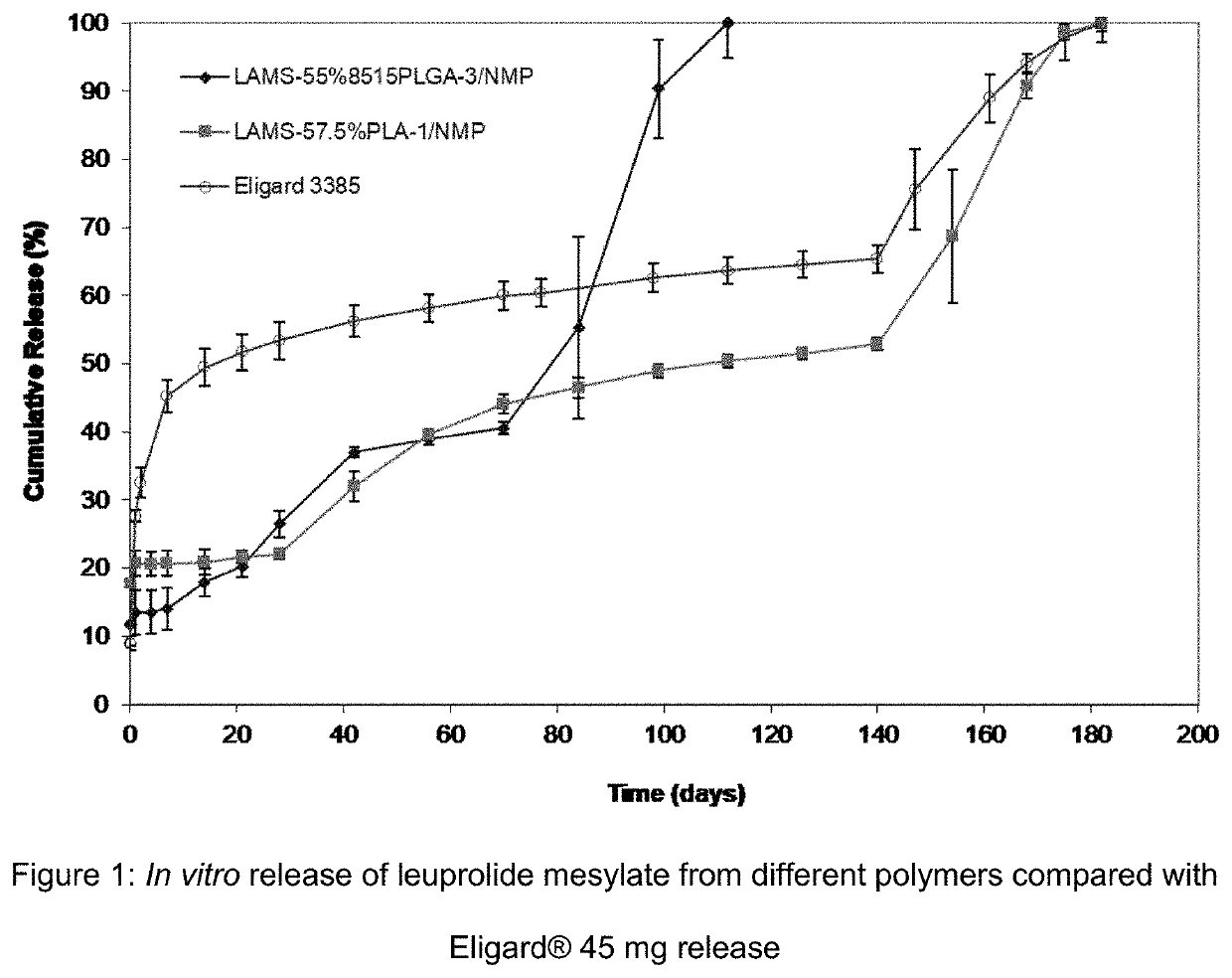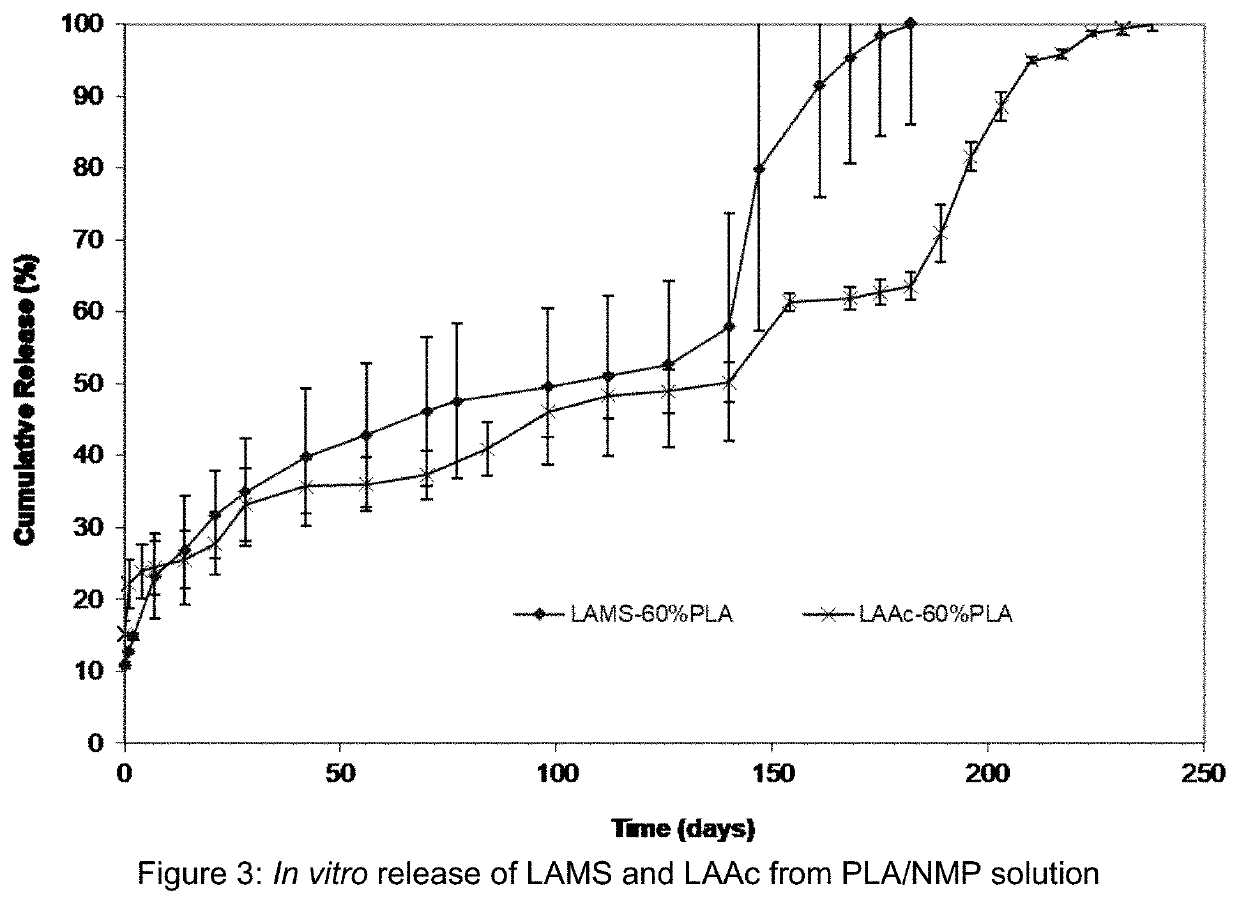Pharmaceutical Compositions having a Selected Release Duration
a technology of pharmaceutical compositions and release durations, applied in the field of delivery systems, can solve the problems of short circulation half-life, inconvenient injection administration, and inability to stabilize peptide agents, and achieve the effects of satisfactory storage stability, reduced interaction/reaction between peptide agents and polymers, and reduced peptide/protein interactions or preventing interactions
- Summary
- Abstract
- Description
- Claims
- Application Information
AI Technical Summary
Benefits of technology
Problems solved by technology
Method used
Image
Examples
example 1
of Peptide Agent and Biodegradable Polymer in Injectable Polymeric Compositions
[0113]Poly(DL-lactide-co-glycolide) (PLGA) of an 85 / 15 ratio of lactide to glycolide (DLPLG85 / 15, IV: 0.28) with a lauryl ester end group was dissolved in N-methyl-2-pyrrolidone (NMP) to give a 50% solution by weight. The leuprolide salts were mixed with the PLGA solution in NMP to give a uniform injectable composition at ratios shown in the Table 1. The injectable compositions were filled into 1.2 mL polypropylene syringes with luer-lock tips. Then the pre-filled syringes were sealed using luer-lock caps. The capped syringes were packaged in a container and sealed in a plastic bag under vacuum and then stored at 4° C. and room temperature (˜22° C.) for up to 18 months. The injectable composition was sampled at 24 h, 1, 2, 3, 6, 12, and 18-month time points. Purity of leuprolide in the sample was determined by HPLC. Molecular weight of the polymer was determined by gel permeation chromatography (GPC) usin...
example 2
of Leuprolide Over 6 Months
[0116]Eligard® 45 mg can deliver leuprolide acetate for 6 months. The product is supplied in 2 separate syringes with the leuprolide acetate in one syringe and the polymer solution in the other. The two are mixed immediately prior to injection. The polymer solution contains a 50% 8515PLGA polymer solution in NMP. The molecular weight of the polymer is about 20 k dalton. A comparable formulation was made using leuprolide mesylate having a molar ratio of mesylate to leuprolide of 1.55:1 (LAMS(1.55)) with a similar 8515PLGA polymer. This polymer had a molecular weight around 20 k dalton as well and a polydispersity index (PDI) of 1.7. The leuprolide mesylate was prepared from leuprolide acetate by ion exchange lyophilization process and contains a small amount of acetate. The formulation was mixed and stored in a single syringe. Another formulation was made with LAMS using a PLA polymer with a molecular weight of 15 k dalton (PLA-1) and a polydispersity index...
example 3
of Leuprolide In Vivo Over 6 Months
[0118]The objectives of this study were to characterize the pharmacokinetics of depot formulations containing leuprolide mesylate following a single subcutaneous dose in male rats for a period of 7 months and to investigate the effect of different polymers and activity of the formulations following SC administration in rats. Eligard® 45 mg served as reference drug. The release of leuprolide (LA) was determined by analyzing the serum concentrations of LA as a function of time after SC administration.
[0119]Male rats were divided into groups (6 / group) and received the following leuprolide mesylate (LAMS1.55) formulations. 55.2% 8515PLGA-3 / 44.8% NMP (irradiation dose 25 kGy), 57.6% PLA-1 / 42.4% NMP (irradiation dose 25 kGy), or a reference drug, Eligard® 45 mg. The 8515PLGA-3 polymer had a molecular weight similar to the molecular weight of the Eligard® 45 mg (20 k) and the PLA-1 polymer had a molecular weight of 15 k. Blood samples were collected prior...
PUM
| Property | Measurement | Unit |
|---|---|---|
| polydispersity | aaaaa | aaaaa |
| molar ratio | aaaaa | aaaaa |
| molar ratio | aaaaa | aaaaa |
Abstract
Description
Claims
Application Information
 Login to View More
Login to View More - R&D
- Intellectual Property
- Life Sciences
- Materials
- Tech Scout
- Unparalleled Data Quality
- Higher Quality Content
- 60% Fewer Hallucinations
Browse by: Latest US Patents, China's latest patents, Technical Efficacy Thesaurus, Application Domain, Technology Topic, Popular Technical Reports.
© 2025 PatSnap. All rights reserved.Legal|Privacy policy|Modern Slavery Act Transparency Statement|Sitemap|About US| Contact US: help@patsnap.com



